八年级下册英语第一单元笔记教案资料
八下英语unit1优秀教案
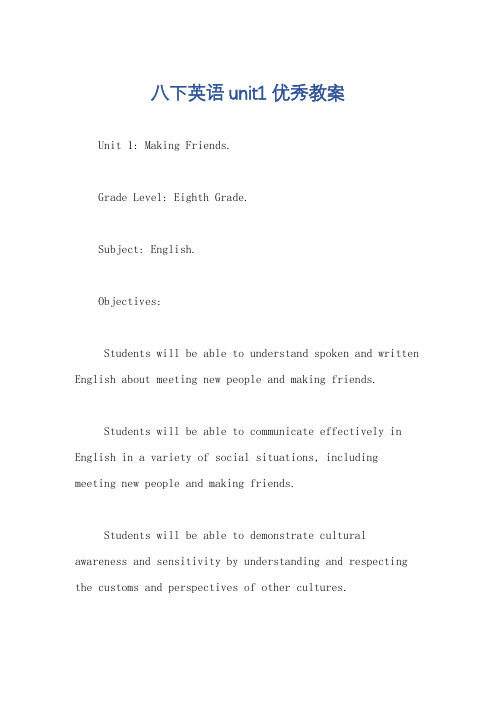
八下英语unit1优秀教案Unit 1: Making Friends.Grade Level: Eighth Grade.Subject: English.Objectives:Students will be able to understand spoken and written English about meeting new people and making friends.Students will be able to communicate effectively in English in a variety of social situations, including meeting new people and making friends.Students will be able to demonstrate cultural awareness and sensitivity by understanding and respecting the customs and perspectives of other cultures.Materials:Textbook: Any eighth-grade English textbook that includes a unit on making friends.Whiteboard or chart paper.Markers.Sticky notes.Handouts.Music player.Music.Procedure:Warm-up (5 minutes)。
Begin the lesson by asking students to think about atime when they met someone new.Have students share their experiences with the class.Introduction (10 minutes)。
八年级下册英语u1课文笔记
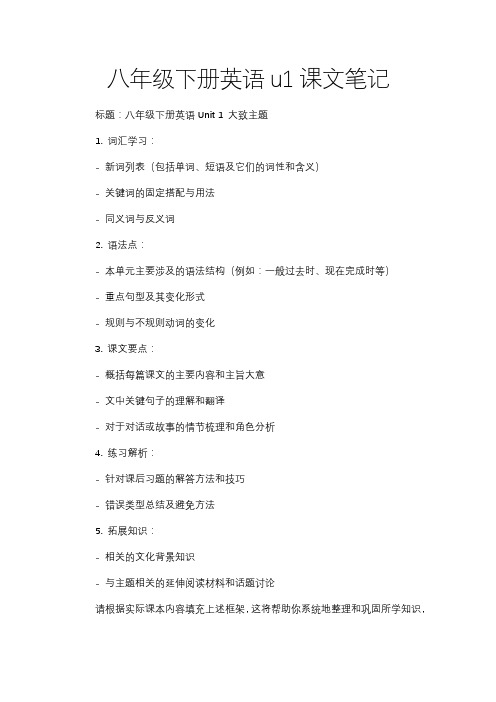
八年级下册英语u1课文笔记
标题:八年级下册英语Unit 1 大致主题
1. 词汇学习:
- 新词列表(包括单词、短语及它们的词性和含义)
- 关键词的固定搭配与用法
- 同义词与反义词
2. 语法点:
- 本单元主要涉及的语法结构(例如:一般过去时、现在完成时等)
- 重点句型及其变化形式
- 规则与不规则动词的变化
3. 课文要点:
- 概括每篇课文的主要内容和主旨大意
- 文中关键句子的理解和翻译
- 对于对话或故事的情节梳理和角色分析
4. 练习解析:
- 针对课后习题的解答方法和技巧
- 错误类型总结及避免方法
5. 拓展知识:
- 相关的文化背景知识
- 与主题相关的延伸阅读材料和话题讨论
请根据实际课本内容填充上述框架,这将帮助你系统地整理和巩固所学知识,
并为后续的学习打下坚实的基础。
记得结合老师的讲解和个人理解,形成个性化的笔记,以便更好地吸收和运用所学内容。
八年级下册英语第一单元知识点笔记
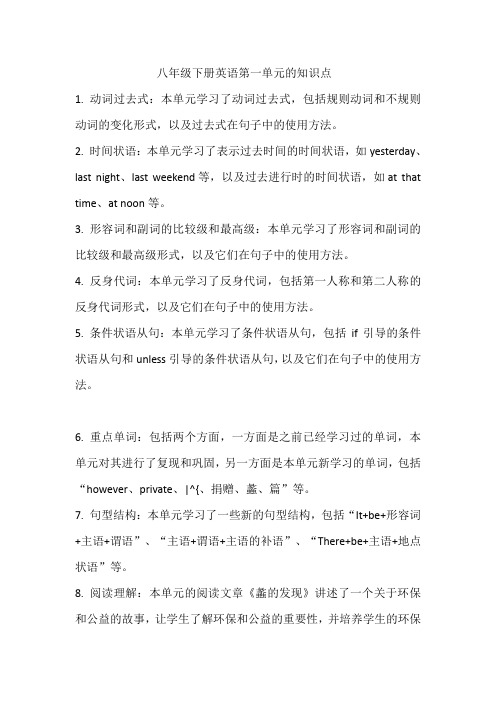
八年级下册英语第一单元的知识点
1. 动词过去式:本单元学习了动词过去式,包括规则动词和不规则动词的变化形式,以及过去式在句子中的使用方法。
2. 时间状语:本单元学习了表示过去时间的时间状语,如yesterday、last night、last weekend等,以及过去进行时的时间状语,如at that time、at noon等。
3. 形容词和副词的比较级和最高级:本单元学习了形容词和副词的比较级和最高级形式,以及它们在句子中的使用方法。
4. 反身代词:本单元学习了反身代词,包括第一人称和第二人称的反身代词形式,以及它们在句子中的使用方法。
5. 条件状语从句:本单元学习了条件状语从句,包括if引导的条件状语从句和unless引导的条件状语从句,以及它们在句子中的使用方法。
6. 重点单词:包括两个方面,一方面是之前已经学习过的单词,本单元对其进行了复现和巩固,另一方面是本单元新学习的单词,包括“however、private、|^{、捐赠、蠡、篇”等。
7. 句型结构:本单元学习了一些新的句型结构,包括“It+be+形容词+主语+谓语”、“主语+谓语+主语的补语”、“There+be+主语+地点状语”等。
8. 阅读理解:本单元的阅读文章《蠡的发现》讲述了一个关于环保和公益的故事,让学生了解环保和公益的重要性,并培养学生的环保
意识。
9. 语法知识:本单元学习了简单句和复合句的区别,以及如何将多个简单句组合成复合句。
八年级英语(下)第1单元第一课时教案
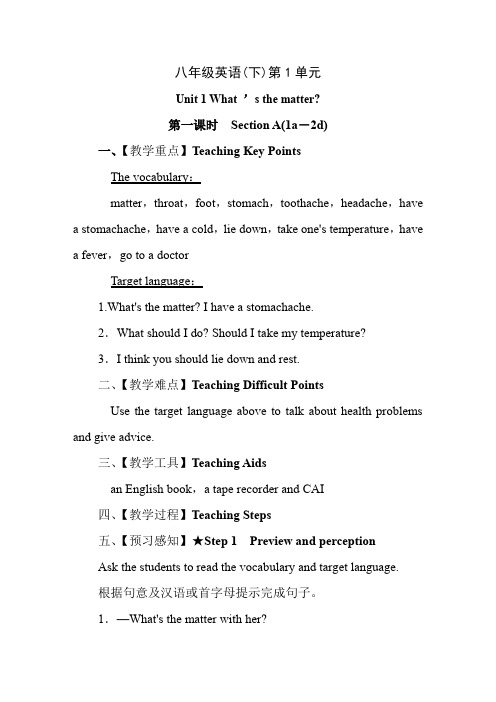
八年级英语(下)第1单元Unit 1 What ’s the matter?第一课时Section A(1a-2d)一、【教学重点】Teaching Key PointsThe vocabulary:matter,throat,foot,stomach,toothache,headache,have a stomachache,have a cold,lie down,take one's temperature,have a fever,go to a doctorTarget language:1.What's the matter? I have a stomachache.2.What should I do? Should I take my temperature?3.I think you should lie down and rest.二、【教学难点】Teaching Difficult PointsUse the target language above to talk about health problems and give advice.三、【教学工具】Teaching Aidsan English book,a tape recorder and CAI四、【教学过程】Teaching Steps五、【预习感知】★Step 1Preview and perceptionAsk the students to read the vocabulary and target language.根据句意及汉语或首字母提示完成句子。
1.—What's the matter with her?—She has a very sore t______ now.2.He ate too much,so he had a s______.3.If you feel tired,you should l______ down and rest.4.If you ______(咳嗽),drink some hot tea with honey.5.He wants to see a dentist,because he has a ______(牙疼).★Step 2Consociation and exploration【合作探究】Let the students read the book by themselves in order to find out the answers.They can discuss the questions in groups or ask the teacher for help.When they finish the questions,ask some students to check the answers.★Step 3Leading in【情景导入】Ask a student to act something is wrong with his/ her head…And T:What's the matter?Help the students to answer:I have a…Have the students repeat.★Step 4Pre-task【准备任务】Page 1,1a &1b1.Look at the picture.Write the correct letter [a-m] for each part of the body.2.Match each activity.3.Play the tape and ask the students to listen and find the answers.Page 1,1c1.Focus on the conversation in the box.2.Practice reading.3.Pairwork:Ask the students to look at the picture and practice in pairs like this:S1:What's the matter?S2:I have…4.Groupwork: Divide the class into some groups.Make conversations.S1:What's the matter?S2:She talked too much yesterday and didn't drink enough water.She has a very sore throat now.S3:…★Step 5While-task【过程任务】Page 2,2a&2b1.Play the recording for the first time.Students listen and number the pictures [1-5] in order.2.Check the answers.3.Play the recording a second time and say:There are five conversations.Some have some problems and the others give them some advice.Listen and match the problems with the advice.★Step 6Post-task【后续任务】Page 2,2c & 2d1.Focus on the conversation in 2c & 2d.2.Practice reading.Make the students scan the conversations first.3.Teach and then make the students role-play the conversation in pairs.4.Play the recording and ask the students to listen and repeat 2d.★Step 7Consolidation practice【巩固练习】Look at the students' book of the 1st exercise.★Step 8Summary【课堂小结】In this class we should master “matter,stomach,toothache,headache,have a stomachache,have a cold,take one's temperature”and some sentences in target language.★Step 9Homework【家庭作业】1.Listen to the tapes twice.2.Practice the conversation on Page 2,2d.Board Design板书设计Unit 1What's the matter?The first period Section A(1a-2d)1.Key vocabulary:have a stomachache;have a cold; lie down;take one's temperature;have a fever;go to a doctor2.Target language:(1)What's the matter? I have a stomachache.(2)What should I do? Should I take my temperature?(3)I think you should lie down and rest.。
八下英语第一单元课堂笔记
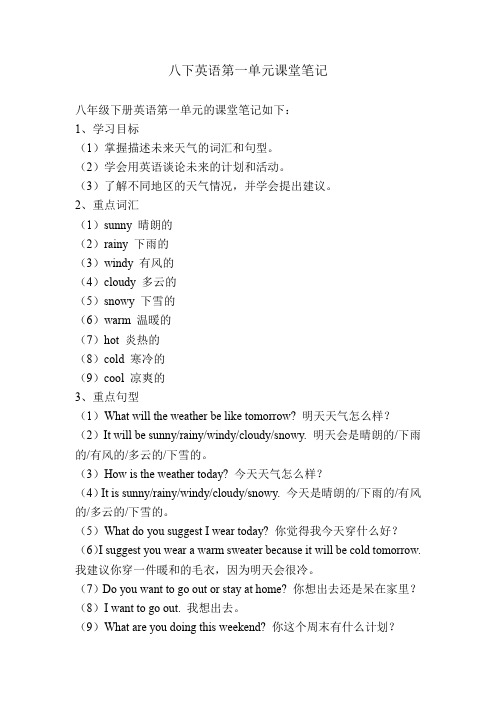
八下英语第一单元课堂笔记八年级下册英语第一单元的课堂笔记如下:1、学习目标(1)掌握描述未来天气的词汇和句型。
(2)学会用英语谈论未来的计划和活动。
(3)了解不同地区的天气情况,并学会提出建议。
2、重点词汇(1)sunny 晴朗的(2)rainy 下雨的(3)windy 有风的(4)cloudy 多云的(5)snowy 下雪的(6)warm 温暖的(7)hot 炎热的(8)cold 寒冷的(9)cool 凉爽的3、重点句型(1)What will the weather be like tomorrow? 明天天气怎么样?(2)It will be sunny/rainy/windy/cloudy/snowy. 明天会是晴朗的/下雨的/有风的/多云的/下雪的。
(3)How is the weather today? 今天天气怎么样?(4)It is sunny/rainy/windy/cloudy/snowy. 今天是晴朗的/下雨的/有风的/多云的/下雪的。
(5)What do you suggest I wear today? 你觉得我今天穿什么好?(6)I suggest you wear a warm sweater because it will be cold tomorrow. 我建议你穿一件暖和的毛衣,因为明天会很冷。
(7)Do you want to go out or stay at home? 你想出去还是呆在家里?(8)I want to go out. 我想出去。
(9)What are you doing this weekend? 你这个周末有什么计划?(10)I am going hiking with my family. 我打算和家人去徒步旅行。
4、语法重点(1)使用will表示未来时间的动作或状态。
(2)使用形容词描述天气状况。
(3)使用动词短语表达建议和意见。
八年级下册人教版英语u1备课笔记

八年级下册人教版英语u1备课笔记English: In the eighth grade English textbook, Unit 1 focuses on the theme of "Have you ever been to a museum?" The unit begins with a Warm-up section where students are introduced to different types of museums such as art museums, history museums, and science museums. This section aims to activate students' prior knowledge and encourage them to share their own experiences of visiting museums. The next section is called Listening, which provides two listening tasks related to museum visits. Students are required to listen for specific information and answer comprehension questions. After that, there is a Reading section where students read a passage about the British Museum in London. This passage aims to develop students' reading comprehension skills, including understanding main ideas, supporting details, and understanding vocabulary in context. Following the reading passage, there are vocabulary and grammar sections. The vocabulary section introduces students to new words and phrases related to museums, such as exhibition, collection, and souvenir. The grammar section focuses on the present perfect tense and its usage in talking about past experiences, which is closely connected to the theme of visiting museums. Toconsolidate students' learning, there are Writing and Speaking sections. In the Writing section, students are guided to write a short composition about their own museum visit by using the information provided in a chart. In the Speaking section, students are asked to work in pairs or groups and have conversations about their favorite museums and reasons for liking them. Throughout the unit, there are various opportunities for students to practice their four language skills: listening, speaking, reading, and writing.中文翻译:在八年级英语教材的第一单元中,主题为“你去过博物馆吗?”单元以热身部分开始,学生被介绍了不同类型的博物馆,如艺术博物馆,历史博物馆和科学博物馆。
知识的源泉,学习的宝库——八年级下unit1教案学习笔记

知识的源泉,学习的宝库——八年级下Unit1教案学习笔记在日复一日的生活中,我们需要不断学习和积累知识,才能更好地适应社会的变化和发展。
而八年级下Unit1教案作为一种有效的学习工具,不仅可以帮助我们获取新的知识和技能,还可以提高我们的学习效率,助力我们在学习路上稳步前行。
一、认识学科:英语英语作为一门国际通用语言,是我们必须学习的科目之一。
在本节课中,我们了解了英语的具体内容和对象,并学会了如何正确地学习英语。
我们需要掌握英语单词的发音和意思,再去学习基本的语法知识以及听力和口语技能。
我们需要沉浸在英语学习中,通过阅读、听力和写作来提高英语水平。
我们还需要学会如何使用语言,以便实现更高的沟通和交流效果。
英语学科是一个凝聚各个方面的综合学科,它需要我们细心、耐心地学习和实践。
二、认识单元主题:Welcome to the unit本节课的主题是“欢迎来到本单元”。
通过这个主题,我们可以了解到一些关于英语学习的基本信息,例如英语词汇、语法知识、学习方法等等。
同时,本课重点介绍了一些在英语学习中比较常用的短语,例如“keep practicing”(不断练习)、“pay attention to”(注意)等等。
通过这些短语的学习,我们可以更好地理解英语学科的基本要求和方法,从而快速提高我们的英语水平。
三、认识教学目标教学目标是本节课一个重要的组成部分,它可以帮助我们更好地了解这堂课的学习内容和学习方向。
从本节课的教学目标来看,可以看出教师的教学思路和教学要求。
在这里,教师主要希望我们学会以下三个方面的内容:一、了解英语学科的组成和学习方法;二、理解本单元主题和相关的学习内容;三、通过不断的实践和练习来提高英语水平。
通过这样的学习目标,我们可以更好地把握本单元的重点,更好地实现我们的学习目标。
四、认识教学规划教学规划是教师针对本节课的具体内容和学生的实际需求制定的课程计划。
从本节课的教学规划来看,我们可以了解到本课的教学内容、教学方法和教学步骤等等。
八年级下册英语第一单元教学教案5篇
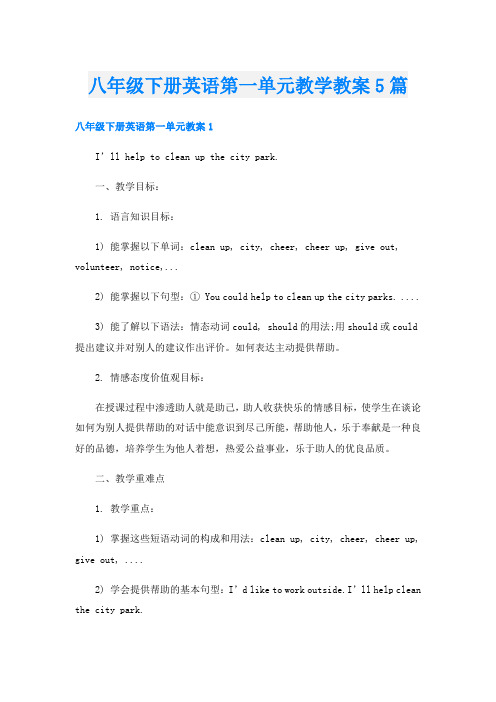
八年级下册英语第一单元教学教案5篇八年级下册英语第一单元教案1I’ll help to clean up the city park.一、教学目标:1. 语言知识目标:1) 能掌握以下单词:clean up, city, cheer, cheer up, give out, volunteer, notice,...2) 能掌握以下句型:① You could help to clean up the city parks. ....3) 能了解以下语法:情态动词could, should的用法;用should或could 提出建议并对别人的建议作出评价。
如何表达主动提供帮助。
2. 情感态度价值观目标:在授课过程中渗透助人就是助己,助人收获快乐的情感目标,使学生在谈论如何为别人提供帮助的对话中能意识到尽己所能,帮助他人,乐于奉献是一种良好的品德,培养学生为他人着想,热爱公益事业,乐于助人的优良品质。
二、教学重难点1. 教学重点:1) 掌握这些短语动词的构成和用法:clean up, city, cheer, cheer up, give out, ....2) 学会提供帮助的基本句型:I’d like to work outside.I’ll help clean the city park.2. 教学难点:学会提供帮助的基本句型三、教学过程Period 1(Section A 1a-2d)Step 1 Warming up1. 播放学生志愿者进行义务帮助别人的活动视频,通过询问他们以下问题来引导学生们了解社会上一些的志愿们进行的活动。
Step 2 New words Read new words on p9-10.Step 3 Discussion1. 1a. Look at the ways you could help others. Then list other ways.2. Ss discuss with their partners and write the ways one could help others:① Help plant trees by the river. ② Help clean up the city park.③ Visit the old people in the old people’s home. ④ Help young kids to learn English.Step 4 Listening1. T: Tell Ss to read the sentences in the chart. Make sure they know the meaning of the sentences.2. 1b. Play the recording for the Ss to listen and number the ways the boy and girl could help others.Step 5 Pair work1. Let Ss read the conversation in the picture.2. 1c. Use the information in the chart of 1b to make other conversations.A: I hope to work outside.B: You could help to clean up the city parks. ........3. Let some pairs act out their conversations.Step 6 Listening1. 2a:T: A group of students are planning a City Park Clean-up Day. Listen and check (√) the things they are going to do to tell people about it.1. Look at the pictures in 2a. Discuss the things they are going to do.2. Play the recording for the Ss to listen and check the pictures.3. Play the recording again to check the answers.2. 2b:1. Let Ss read the sentences below. Explain some main sentences for the Ss. Make sure they know what to do.2. Play the recording for the Ss to write the correct words in the blanks.3. Play the recording again to check the answers.Step 7 Pair work1. 2c. Tell Ss to make a conversation using the information in 2a and 2b.2. Let one pair to read out thei r conversation first.e.g. A: We need to come up with a plan for the City Park Clean-Up Day.B: Let’s have lunch first.A: No, we need to start now. Clean-Up Day is only two weeks from now.B: You’re right. We can’t put off making a plan. As we talk, I’ll write down all our ideas. Then we can decide which ideas are best.A: Let’s make some notices, too. Then I’ll hand them out after school.B: And we could each call up ten students and ask them to come.3. Ss act the conversation in pairs. Ask some pairs to act out their con versations.Step 8 Reading and Role-play1. Read the conversations and answer the two questions:① Where’s Helen going to work this summer?__________________________________② What did Tom do to help the old people?____________________________________Answers: She’s going to work in an old people’s home.Reading the newspaper or just talking to the old people.2. Read the conversation after the teacher.3. Practice the conversation with their partner. Then let some pairs to act out the conversation.Homework:Teaching thought:Period 2(Section A 3a-3c)Step 1 Revision1. Write down the phrases.1. 打扫 ________2. 分发 ________3. 曾经 _______4. (使)变得高兴 ________5. 义务做某事 _________________6. 大打扫日 ______________7. 想出主意(办法)____________2. Role-playA: Hi, Tom. I’m making some plans to work in an old people’s home this summer.B: Really? I did that last summer!Step 2 New words Read new words on p11.Step 3 Reading1.Tell Ss to read the article in 3a quickly and try to find the answers to these questions:1. What does Mario love?2. What does Mary love?3. What do Mario and Mary volunteer to do?Ss read the article quickly and try to answer the questions:Answers: 1. He loves animals.2. She loves reading books.3. Mario volunteers at animal hospital and Mary helps kids learn to read.2.3b: Read the article again and answer the questions.1. Why does Mario volunteer to help others?2. Why does Mary volunteer to help others?3. What does Mario say about volunteering?4. What does Mary say about volunteering?Answers: 1. Because he believes it can help him to get his future dream job.2. Because she can do what she loves to do and help others.3. He gets such a strong feeling of satisfaction when he sees the animals get better and the look of joy on their owners’ face.4. Volunteering is a dream come true for her.Homework Make sentences with these words.help (to) do; want to do; learn to do; decide to do; how to do; volunteer to doTeaching thought:Period 3(Grammar Focus-4c)Step 1 RevisionComplete the sentences.Mario and Mary ____ ___ several hours each week __ ____ others. Mario wants __ ___ an animal doctor. He _________ at an animal hospital. He wants __ _____ more about ____ __ care for animals.Mary is a book lover. She could read by herself __ ___ ____ of four. Last year, she decided __ ___ ___ for a volunteer after-school _______ program. Mary still works there once a week __ ____ kids _____ __ read. Volunteering here is a dream come true for her. She can what she _____ ___ ___and helps others at the same time.Can you tell something about Mary to us?Answers: give up, to help, to be, volunteers, to learn, how to, at the age, to try out, reading, to help, learn to, loves to do Step 2 Grammar focus1. 阅读Grammar Focus中的句子,然后做填空练习。
人教版八年级英语下册Unit 1(1)教案

新人教版八年级英语下册Unit 1(1)教案Teaching goals:1. Words&phrases: robot, paper, less, fewer, simple, unpleasant, factory, seem, etc .2. will 构成的一般将来时态的陈述句、否定句、疑问句及回答.3. There be 句型的一般将来时.4. more , less , fewer 的用法.5. 学习一般将来时态的相关知识,学会对未来进行预测.6. 对five years ago ,today ,in five years 简洁回顾与展望的方式,贴近实际符合学生心理,激发学习兴趣.7. 通过时间对比复习一般过去时态、一般现在时态,巩固一般将来时.Important and difficult points :1. will构成一般将来时态的句式。
2. There be 句型的一般将来时态。
3. more , fewer , less 的用法。
4. How to make predictions .Period 1Teaching procedures:Step 1 Leading in1. Greetings: Welcome to sc hool .What’s the date today ? Who’s on duty today ?Do you enjoy your winter holiday ?Do you finish your homework ?Do you want to live on the moon ?Can you guess what will happen in ten years ?Collect the Ss’ answers and say something about their predictions .Step 2 Pre-taskPage 2 ,1a .1. Look at the picture :How will the world be different in the future ,100 years from now ?We’re going to talk about sth in 100 years .2. Read each predictions to the class .Explain the new vocabulary .3. Read the instructions .Make sure Ss know what they should do .4. Do it by themselves .5. Talk about the answers with the class .Explain :一般将来时态构成: will / be going to +动词原形Step 3 While-taskPage 2 ,1b .1. Practise reading the six predictions .2. Read the instructions to Ss .Circle the things you hear on the recording .3. Play the tape twice .4. Play the tape a third time .At the same time ,check the answers .Page 2 , 1c .1. Pay attention to the dialogues .2. Read the dialogues fluently .3. Pairwork .Work in pairs to make predictions according to the sample .4. Ask several pairs to share their conversations to the class .Page 3 , 2a & 2b .1. Read the predictions .2. Read the instructions and point out the sample answer .3. Play the tape twice .Ss circle the word they hear in each sentences: more , less , fewer .4. Check the answers .学生探究: less , fewer 的区别。
人教版八年级下册英语Unit1(第一单元)优秀教案
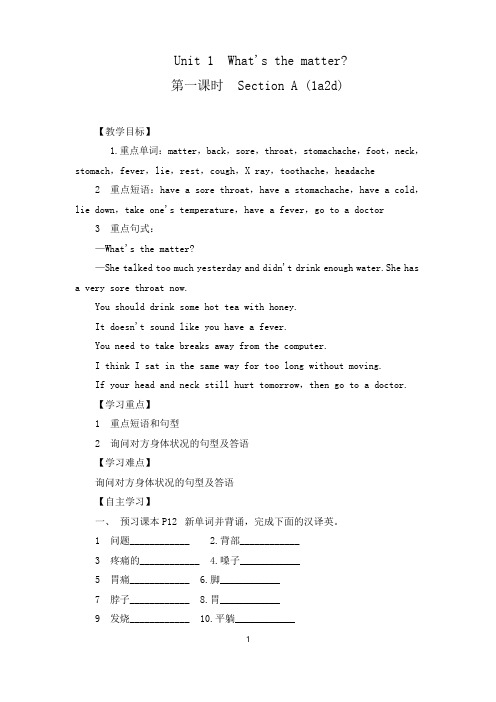
Unit1What's the matter?第一课时Section A(1a2d)【教学目标】1.重点单词:matter,back,sore,throat,stomachache,foot,neck,stomach,fever,lie,rest,cough,X ray,toothache,headache 2重点短语:have a sore throat,have a stomachache,have a cold,lie down,take one's temperature,have a fever,go to a doctor 3重点句式:—What's the matter?—She talked too much yesterday and didn't drink enough water.She has a very sore throat now.You should drink some hot tea with honey.It doesn't sound like you have a fever.You need to take breaks away from the computer.I think I sat in the same way for too long without moving.If your head and neck still hurt tomorrow,then go to a doctor.【学习重点】1重点短语和句型2询问对方身体状况的句型及答语【学习难点】询问对方身体状况的句型及答语【自主学习】一、预习课本P12新单词并背诵,完成下面的汉译英。
1问题____________ 2.背部____________3疼痛的____________ 4.嗓子____________5胃痛____________ 6.脚____________7脖子____________8.胃____________9发烧____________10.平躺____________11休息____________12.咳嗽____________13X光____________14.牙疼____________15头疼____________二、认真预习1a2d找出下列短语和句型。
最新】牛津译林版八年级英语下册Unit1教案
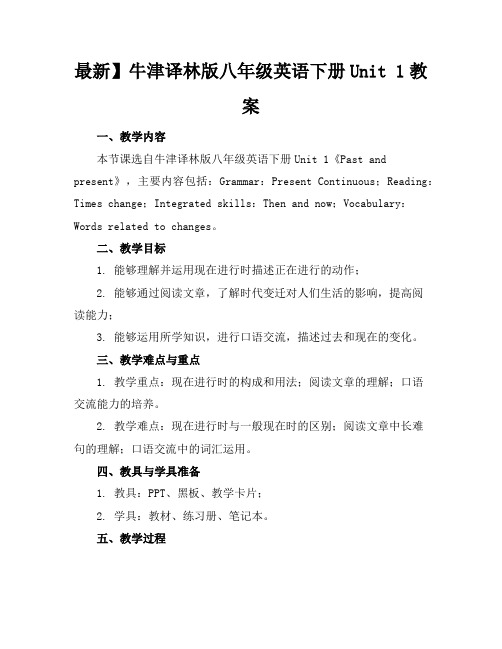
最新】牛津译林版八年级英语下册Unit 1教案一、教学内容本节课选自牛津译林版八年级英语下册Unit 1《Past and present》,主要内容包括:Grammar:Present Continuous;Reading:Times change;Integrated skills:Then and now;Vocabulary:Words related to changes。
二、教学目标1. 能够理解并运用现在进行时描述正在进行的动作;2. 能够通过阅读文章,了解时代变迁对人们生活的影响,提高阅读能力;3. 能够运用所学知识,进行口语交流,描述过去和现在的变化。
三、教学难点与重点1. 教学重点:现在进行时的构成和用法;阅读文章的理解;口语交流能力的培养。
2. 教学难点:现在进行时与一般现在时的区别;阅读文章中长难句的理解;口语交流中的词汇运用。
四、教具与学具准备1. 教具:PPT、黑板、教学卡片;2. 学具:教材、练习册、笔记本。
五、教学过程1. 导入:通过展示一组对比鲜明的图片,引导学生观察并讨论过去和现在的变化,激发学习兴趣。
2. 新课内容呈现:(1) 通过PPT展示现在进行时的构成和用法,结合实例进行讲解;(2) 引导学生阅读文章《Times change》,分析文章结构,理解文章内容;(3) 指导学生进行口语交流,讨论过去和现在的变化。
3. 例题讲解:结合教材中的例题,讲解现在进行时的用法,并进行拓展。
4. 随堂练习:设计相关练习题,巩固所学知识。
5. 小组活动:分组进行口语交流,讨论生活中的变化,并进行展示。
六、板书设计1. 板书左侧:现在进行时的构成和用法;2. 板书右侧:文章《Times change》的结构框架;3. 中间部分:例题及解答过程。
七、作业设计1. 作业题目:(1) 根据所学知识,编写一段对话,描述正在进行的动作;(2) 阅读文章《Times change》,回答相关问题;(3) 结合生活实际,写一篇短文,介绍过去和现在的变化。
人教版英语八年级下册 Unit1 Section A (3a-3c) 教案设计

人教版英语八年级下册Unit 1 what’s the mattersection A (3a-3c)一.Teaching aims:1.knowledge aims:1)words and phrases :passenger, get off, on to, to one’s surprise, trouble, hit, right away, get into, herself, see sb doing sth, thanks to, save a life, think about, in time, tell…to do…2)consolidate the past tense and be proficient in past form of the verb.2.Ability aims:Solve reading comprehension problem by the way of inference judgement3.moral education:foster the student’s spirit of helping other people who are in danger. They will have courage to make a right decision, when they face emergency.二.important and difficult teaching points1.important teaching points:the revision of the past tense;2.difficult teaching points:draw the informationfrom the reading material.三.teaching processStep1 review what we learned yesterday and talk about what we should do when we seesomebody get into trouble.Step2 let students read the article of page3 by themselves,give someone a chance to tell usthe main idea of the article.Step3 after reading the article, analysis some structures, grammers and important pointstogether with students.See sb doing sth see sb do sth get offWithout doing sth in time think aboutThanks to wait for agree to…Step4 Read the passage again and check the things that happened in the story on page 3知识点归纳:用have回答健康问题(1)Have a cold 中have 意为”患,得”(病)(2)Have 意为”拥有”之意时无进行时(3)Have 做”吃,喝”解,可指吃三餐或具体食物Eg: I have eggs for breakfast(4)Have 做”上….课”解,Eg: How mangclasses do you have on weekdays.Step5 3c Discuss the questions with a partner on page3 Step6 Practice1.I tried to make Alice__ her mind but I found itdifficult.Well, I saw you__ that when I went past.A.changed; doB. changes; doingC.change; to doD. change; doing2.Could you please give me a hand? I can’tcomplete the task on time__ your help.A. withoutB. underC. withD. for3.This bus doesn’t go to the train station. I’m afraidyou’ll have to__ at Hongshan stop and take BRT Line 1.A. take offB. put offC. get offD. get out4.__the NO.48 bus driver, all the passengers weresaved. The driver managed to stop the bus before he died.A. Thanks toB. According toC. As for 四.HomeworkRead the passage again and repeat the main idea in your own words next period.五.Blackboard design。
八年级英语下Unit1教案(全)

Unit 1 What’s the matter?教学目标:1语言目标:描述健康问题的词汇,及如何根据别人的健康问题提建议。
2 技能目标:能听懂谈论健康问题的对话材料;能根据别人的健康问题提建议;能写出重点单词和重点句型,并能描述怎样对待健康问题。
3 情感目标:通过开展扮演病人等活动,培养学生关心他人身体健康的品质。
通过本课的阅读,培养学生处理紧急事件的基本能力,树立紧急事件时互相帮助的精神。
教学重点:短语: have a stomachache, have a c old, lie down, take one’s temperature, go to a doctor, get off, to one’s surprise, agree to do sth., get into trouble,fall down, be used to, run out (of), cut off , get out of, be in control of ,keep on (doing sth.), give up句子:1 What’s th e matter? I have a stomachache. You shouldn’t eat so much next time.2 What’s the matter with Ben?He hurt himself. He has a sore back.He should lie down and rest.3 Do you have a fever? Yes, I do. No, I don’t. I don’t know.4 Does he have a toothache? Yes, he does.He should see a dentist and get an X-ray.5 What should she do? She should take her temperature.6 Should I put some medicine on it? Yes, you should No, you shouldn’t.教学难点:掌握情态动词should \shouldn’t. 的用法学习have的用法课时划分:Section A1 1a – 2d Section A2 3a-3c Section A3 Grammar Focus-4c Section B1 1a-2e Section B2 3a-Self checkSection A 1 (1a – 2d)Step 1 Warming up and new words1.Look at a picture and learn the parts of the body.2.New words and phrases.Step 2 Presentation1a Look at the picture. Write the correct letter [a-m] for each part of the body.___arm ___ back ___ ear ___ eye ___ foot___hand ___ head ___ leg ___ mouth___ neck ___nose ___ stomach ___ toothStep 3 Listening1b Listen and look at the picture. Then number the names 1-5Listen to the conversations again and fill in the blanks.Conversation 1Nurse: What’s the matter, Sarah?Girl: I ___________.Conversation 2Nurse: What’s the matter, David?Boy: I _________________.Conversation 3Nurse: What’s the matter, Ben?Boy: I _________________.Conversation 4Nur se: What’s the matter, Nancy?Girl: I _________________.Conversation 5Betty: What’s the matter, Judy?Ann: She __________________.Step 4 Speaking1c Look at the pictures. What are the students’ problems? Make conversations.ExamplesA: What’s the matter with Judy?B: She talked too much yesterday and didn’t drink enough water.She has a very sore throat now.A: What’s the matter with Sarah?B: She didn’t take care of herself on the weekend. She was playing withher friends a t the park yesterday. Then it got windy, but she didn’t puton her jacket. Now she has a cold.Step 5 Guessing gamesGuess what has happened to the students by using the important sentences.Step 6 Listening2a Listen and number the pictures [1-5] in the order you hear them.2b Listen again. Match the problems with the advice.Step 7 Speaking2c Make conversations using the information in 2a and 2bA: What’s the matter?B: My head feels very hot.A: Maybe you have a fever.B: What should I do?A: You should take your temperature.Step 8 Role–playImagine you are the school doctor. A few students have health problems.Role-play a conversation between the doctor and the students.2d Role –play the conversationStep 9 Language points and summary1. What’s the matter?这是人们特别是医生和护士询问病人病情时最常用的问句, 意思是“怎么了?”其后通常与介词with连用。
【人教版新目标】英语八年级下册Unit1单元教案
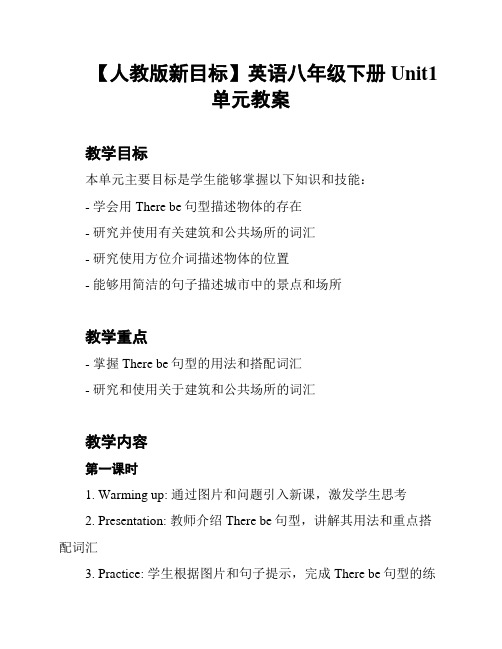
【人教版新目标】英语八年级下册Unit1单元教案教学目标本单元主要目标是学生能够掌握以下知识和技能:- 学会用There be句型描述物体的存在- 研究并使用有关建筑和公共场所的词汇- 研究使用方位介词描述物体的位置- 能够用简洁的句子描述城市中的景点和场所教学重点- 掌握There be句型的用法和搭配词汇- 研究和使用关于建筑和公共场所的词汇教学内容第一课时1. Warming up: 通过图片和问题引入新课,激发学生思考2. Presentation: 教师介绍There be句型,讲解其用法和重点搭配词汇3. Practice: 学生根据图片和句子提示,完成There be句型的练4. Listening: 听录音,完成听力练,提高对There be句型的理解和运用能力第二课时1. Revision: 复There be句型的用法和练2. Vocabulary: 教授与建筑和公共场所相关的词汇,并进行操练3. Listening and speaking: 听录音,回答问题,进行口语练4. Grammar: 通过课文例句,进一步理解方位介词的用法和意义第三课时1. Reading: 学生阅读课文,了解城市景点和场所的描述和位置2. Vocabulary: 教授与城市景点和场所相关的词汇,并进行操练3. Speaking: 学生自由交流,描述自己熟悉的城市景点和场所4. Writing: 学生写一篇短文,介绍自己喜欢的城市景点和场所,运用所学词汇和句型教学扩展- 自主研究:鼓励学生积极参与课后研究,完成相关练和作业- 学科融合:与地理学科结合,通过展示和讨论不同城市的特点和景点等- 实地考察:组织学生到附近的公共场所参观,提高实践能力与综合素养以上为预设的教学内容和安排,教师可根据实际情况进行调整和适当的教学设计。
Unit1What'sthematter人教版英语八年级下册教案

(3)时态运用:一般现在时和现在进行时在本章节的对话和描述中占有重要地位,教师需重点讲解并指导学生如何在询问和描述身体状况时正确运用这两种时态。
二、核心素养目标
《Unit 1 What's the matter》的教学旨在培养学生的英语学科核心素养,具体目标如下:
1.提升学生的语言能力,通过学习本章内容,使学生能够熟练运用英语询问和描述身体状况,表达关心与建议,提高实际生活中的交际能力;
2.增强学生的文化意识,了解和尊重不同文化背景下对待疾病和身体状况的态度及表达方式;
举例:
-当学生询问他人身体状况时,能使用"What's the matter?"这一核心句型;
-当描述自己或他人身体不适时,能运用"I have a stomachache."、"You have a fever."等句型;
-在给出建议时,可以使用"You should take some medicine."等短语。
四、教学流程
(一)导入新课(用时5分钟)
同学们,今天我们将要学习的是《Unit 1 What's the matter》这一章节。在开始之前,我想先问大家一个问题:“你们在日常生活中是否遇到过朋友或家人身体不适的情况?”比如,朋友突然说肚子疼,你会怎么关心和帮助他们呢?这个问题与我们将要学习的内容密切相关。通过这个问题,我希望能够引起大家的兴趣和好奇心,让我们一同探索如何用英语询问和描述身体状况。
八年级下册人教版英语u1备课笔记

八年级下册人教版英语u1备课笔记English: In preparation for teaching the eighth-grade Unit 1 of the People's Education Press English textbook, it is important to first familiarize oneself with the key vocabulary and grammar concepts covered in this unit. The unit focuses on topics such as school life, daily routines, hobbies, and future plans, so it is essential to provide students with ample opportunities for practice and consolidation of language skills in these areas. Additionally, teachers should plan engaging activities and exercises that cater to the diverse learning styles and interests of students to ensure effective learning outcomes. It is also beneficial to incorporate multimedia resources, real-life examples, and interactive technology tools to enhance students' engagement and understanding of the content. Moreover, creating a supportive and inclusive classroom environment where students feel comfortable expressing themselves and participating actively in discussions will contribute to a successful learning experience for all. By approaching the preparation of Unit 1 with thorough planning, creativity, and adaptability, teachers can effectively facilitate students' language acquisition and overall language proficiency in English.Chinese: 在备课八年级下册人教版英语课程的第一单元时,首先要熟悉本单元涵盖的重点词汇和语法概念。
八年级下英语第一单元教案5篇
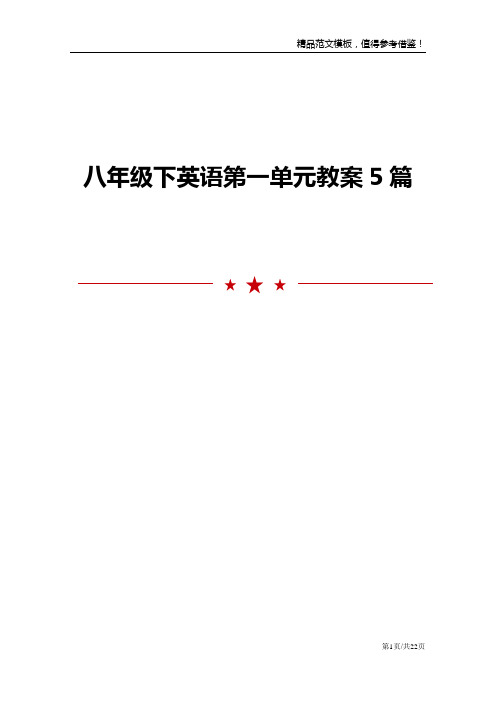
八年级下英语第一单元教案5篇八年级下英语第一单元教案5篇英语是印欧语系-日耳曼语族下的语言,由26个字母组合而成,英文字母渊源于拉丁字母,拉丁字母渊源于希腊字母,而希腊字母则是由腓尼基字母演变而来的。
英语是国际指定的官方语言(作为母语),也是世界上最广泛的第一语言,英语包含约49万词,外加技术名词约30万个,是词汇最多的语言,也是欧盟以及许多国际组织以及英联邦国家的官方语言,拥有世界第三位的母语使用者人数,仅次于汉语和西班牙语母语使用者人数。
以下是带来的八年级下英语第一单元教案内容,感谢您的阅读,希望能帮助到您!八年级下英语第一单元教案1一、指导思想以“英语课程标准”为宗旨,适应新课程改革的需要,面向全体学生,提高学生的人文素养,增强实践能力和创新精神。
正确把握英语学科特点,积极倡导合作探究的学习方式。
培养学生积极地情感态度和正确的人生价值观,提高学生综合素质为学生全面发展和终身发展奠定基础。
二、教材分析《新目标英语》八年级(下册),全书共有十个单元,另两个复习单元,每个单元都列出了明确的语言目标,主要的功能项目与语法结构,需要掌握的基本词汇,并分为A和B两部分。
A部分是基本的语言内容,B部分是知识的扩展和综合的语言运用。
每个单元还附有SELFCHECK部分,学生可用来自我检测本单元所学的语言知识。
本教材各单元话题灵活,贴近生活实际。
在本册书里要学习的一些语法知识点有:一般将来时、过去进行时、现在完成时、间接引语、时间状语从句、条件状语从句、反意疑问句等。
同时每个单元后都提供了一篇阅读文章,用以训练学生的阅读能力,扩大学生的阅读量。
三、具体目标1、要使学生受到听、说、读、写英语的训练,掌握最基础的语言知识和语言技能以及培养初步援用英语交际的能力;养成良好的外语学习习惯,掌握学习外语的基本方法;为进一步学习和运用英语打下扎实的基础。
2、使学生明确学习英语的目的性并且树立学习英语的自信心。
3、培养初步运用英语交际的能力和自学能力。
牛津译林版八年级下册unit1教案

牛津译林版八年级下册unit1教案一、教学内容本节课选自牛津译林版八年级下册Unit 1《Past and present》,涉及章节13。
内容包括:了解和描述过去与现在的变化,运用一般过去时和现在完成时进行表达;学会使用频率副词谈论过去和现在的活动。
二、教学目标1. 能够听懂、会说、会读、会写本节课所学的单词和短语,如:home, used to, population, factory, so far等。
2. 能够运用一般过去时和现在完成时描述过去和现在的变化。
3. 能够通过小组合作,用英语进行交流,探讨家乡的变化。
三、教学难点与重点1. 教学难点:一般过去时和现在完成时的区别及运用。
2. 教学重点:掌握本节课的词汇和短语,以及运用这两种时态描述过去和现在的变化。
四、教具与学具准备1. 教具:多媒体设备、PPT、黑板、录音机等。
2. 学具:课本、练习册、笔记本、字典等。
五、教学过程1. 导入:通过展示一组家乡过去和现在的照片,引导学生谈论家乡的变化,激发学生的学习兴趣。
2. 新课内容展示:a. 学习词汇和短语,结合图片进行展示和讲解。
b. 通过听力练习,让学生感知一般过去时和现在完成时的区别。
c. 引导学生运用这两种时态进行句子练习,巩固语法知识。
3. 例题讲解:结合教材,讲解一般过去时和现在完成时的用法,并进行例句展示。
4. 随堂练习:设计相关练习题,让学生进行口头和书面练习,巩固所学知识。
5. 小组活动:分组讨论,让学生用英语谈论自己家乡的变化,并进行汇报。
六、板书设计1. Unit 1 Past and present2. 主要内容:a. 新单词和短语:home, used to, population, factory,so far等。
b. 语法点:一般过去时和现在完成时的区别及运用。
七、作业设计1. 书面作业:完成练习册上的相关练习题。
2. 口头作业:用英语与家人或朋友谈论家乡的变化。
人教版八年级英语下册《Unit 1》教案
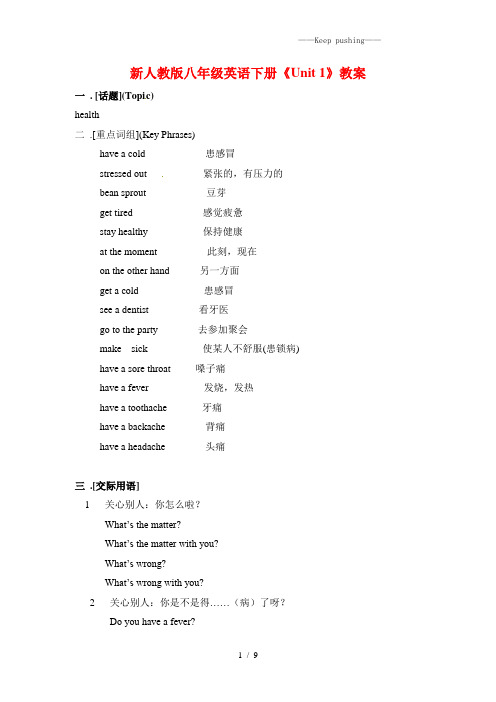
新人教版八年级英语下册《Unit 1》教案一. [话题](Topic)health二.[重点词组](Key Phrases)have a cold患感冒stressed out 紧张的,有压力的bean sprout豆芽get tired感觉疲惫stay healthy保持健康at the moment此刻,现在on the other hand另一方面get a cold患感冒see a dentist看牙医go to the party去参加聚会make sick使某人不舒服(患锁病)have a sore throat嗓子痛have a fever发烧,发热have a toothache牙痛have a backache背痛have a headache头痛三.[交际用语]1 关心别人:你怎么啦?What’s the matter?What’s the matter with you?What’s wrong?What’s wrong with you?2 关心别人:你是不是得……(病)了呀?Do you have a fever?Are you hungry?3 关心别人:你应该……,你最好……,为什么……?You should go to bed early.You shouldn’t eat anything for 24 hours.You’d better go to bed early.You’d better not eat anything for 24 hours.Why not go to bed early?Why don’t you go to bed early?4 关心自己:我不舒服,我病了,我饿了I’m not fe eling well.I have a headache.I am hungry.四. [重点难点释义](Language Points)1.What's the matter, Judy?朱迪,你哪里不舒服?(你怎么了?)matter n.问题,麻烦,事件,通常与介词“with”连用:What's the matter with him?他怎么了?这个句型可以与下面这两个句子互换:What's wrong with him?What's the trouble with him?wrong是形容词,前面没有“the”; matter和trouble都是名词,前面应有“the”, trouble前还可以用形容词性的物主代词。
八年级下册英语第一单元笔记

八年级下册英语第一单元笔记Unit 1 Friendship1.1 Friendship Vocabulary- friend: a person who you trust and like; a person you have a close relationship with- acquaintance: a person you know, but who is not a close friend- loyalty: being faithful and devoted to someone or something- trust: confidence in a person or thing; belief in the reliability, truth, ability, or strength of someone- respect: to hold someone in high regard; to show consideration for another person's feelings, wishes, or rights- kindness: the quality of being friendly, generous, and considerate - honesty: telling the truth and being straightforward- communication: the exchange of information or ideas; the act of conveying thoughts or feelings to another person- support: assistance or encouragement given to someone- empathy: the ability to understand and share the feelings of others 1.2 Friendship Expressions- "A friend in need is a friend indeed." Meaning: A true friend is someone who is there for you when you need them most.- "Birds of a feather flock together." Meaning: People who have similar interests and characteristics tend to enjoy each other's company and spend time together.- "To make friends, you need to be a friend." Meaning: If you want people to be your friend, you need to be kind, respectful, and trustworthy.- "Friends come and go, but true friends stay forever." Meaning: Although some friendships may not last, a true friend is always there for you.- "It's better to have one true friend than 100 fake friends." Meaning: Quality is more important than quantity when it comes to friendships.1.3 Making and Keeping Friends- Show interest in others. Ask questions about them and their interests.- Listen actively. Show that you are paying attention to what they are saying.- Be yourself. Don't try to pretend to be someone you're not.- Respect differences. Everyone is unique and has different experiences and opinions.- Be a good communicator. Speak honestly and openly, but also listen to others and be willing to compromise.- Show loyalty and support. Be there for your friends when they need you, and they will be there for you when you need them.- Offer help and kindness. Whether it's helping them with a task or simply giving them a compliment, show that you care about them. - Share experiences. Spend time doing things together, whether it's a shared hobby or just hanging out.- Be forgiving. No one is perfect, so be willing to forgive and forget when mistakes are made.- Communicate regularly. Don't let time and distance come between you. Keep in touch and stay connected.- Appreciate them. Let your friends know how much they mean to you and how much you appreciate their friendship.。
- 1、下载文档前请自行甄别文档内容的完整性,平台不提供额外的编辑、内容补充、找答案等附加服务。
- 2、"仅部分预览"的文档,不可在线预览部分如存在完整性等问题,可反馈申请退款(可完整预览的文档不适用该条件!)。
- 3、如文档侵犯您的权益,请联系客服反馈,我们会尽快为您处理(人工客服工作时间:9:00-18:30)。
5. I’ll probably go skating and swimming every day. 我可能会天天去滑冰和游泳。
“go + v-ing”是一种固定结构,意思是 “去……”,其中的动词多是表示户外 活动的。
• 和go连用构成固定短语的动词-ing形式
• swimming • shopping • skating • skiing
She watches TV when she is alone. 独自一人时,她便看电视。
【拓展】 lonely作形容词,可意为 “寂寞的”,有较浓厚的感情色彩, 在句中作表语或定语。例如:
I was alone, but I did not feel lonely. 我虽独自一人, 但我不感到寂寞。
She dressed up for a ball. 她穿上盛装去参加舞会。
The children dressed up as policemen. 孩子们把自己打扮成了警察。
• I don’t think he will come. • 我想他不会来的。
• 2. Everything will be free?
• 一切都是免费的?
句中形容词free意思是“免费的”。
• They enjoy free medical care. • 他们享受免费医疗。 • Admission is free for children under 9. • 九岁以下儿童免费。
句中less是副词little的比较级。little可用作 副词, 意思是“少”, 可修饰动词作状语。 You rest too little. 你休息得太少了。
2c
Language focus
There will be…句型 •There will be…是There be句型的拓 展,作“将有;将会有”解。
• 4. I hope so.
• 我希望如此。
句中so是副词,意思是“就像那样; 是这样”,承接前句,以避免重复 前面所说过的内容。
• If you want to go home, just say so.
• 如果你想回家的话,尽管说好了。
People will use the subways less. 人们将较少使用地铁。
2. … because I went to Shanghai last year and fell in love with it. …… 因为我去年到上海,一下子就喜 欢上了它。 fall in love with… 意思是“爱上……”, 其中with是介词,后接名词或代词。
He has fallen in love with Mary. 他已爱上了玛丽。
4. … I don’t like living alone. …… 我不喜欢一个人住。 句中alone是副词,作“单独地”解,多修 饰一个动词作状语。
For years Mary lived alone in New York. 玛丽孤身一人在纽约生活了好几年。
此外,alone还可用作形容词,意思是 “单独的;独自的”,但一般只作表语, 而不能作定语。
•其中will是情态动词。
•那么该句型的否定式和疑问式是什么 样子呢?
There will be more pollution in the future.
否定式:There will not (won’t) be more pollution in the future.
疑问式:Will there be more pollution in the future?
肯定回答: Yes, there will.
肯定回答:No, there won’t.
Language points
1. In ten years, I think I’ll be a reporter. 十年后,我想我会当一名记者。 句中介词in意思是“在……以后”,后接 表示一段时间的词语,多和将来时态连用。 He’ll come back in a week. 他将于一周之后回来。
3. As a reporter, I think I will meet lots of interesting people. 作为一名记者,我想我会认识很多有趣 的人。 句中as是介词, 作“作为”解, 后多接表 示职业的名词。
She works as an interpreter in that company. 她在该公司里担任翻译员。
• 去游泳
• 去购物 • 去滑冰 • 去滑雪
• roller • 去sk滑at旱in冰g
• fishing • hunting • bike riding • 去钓鱼 • 去打猎 • 去骑自行车
• horse riding • hiking
• sightseeing
• 去骑马
• 去远足
• 去观光
6. dress 【例句】
• 3. I think there will be only one country.
• 我认为将来只有一个国家。
there will be … 是There be句型的拓展, 表达“将 大概”解。
• This will be the house you’re looking for. • 这大概就是你找的那所房子了。
Language points on listening
• 1. … I don’t think people will use money. • ……我认为人们就将不再用钱了。
people will use money 是省略了连词that 的宾语从句。当主句是I think结构时, 否 定的宾语从句中的not要前移到主句。
Get up and dress quickly. 赶快起床穿衣服。
The mother is dressing her baby. 母亲正在给婴儿穿衣服。 【点拨】 dress可作不及物动词, 意为“穿好衣裳”;dress还可作及物 动词,意为“给……穿好衣裳”。
【拓展】 dress up意为“穿上盛装、打 扮”。例如:
